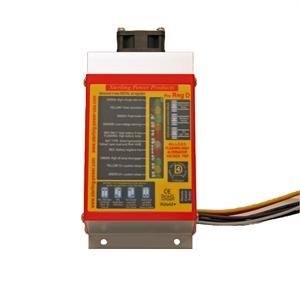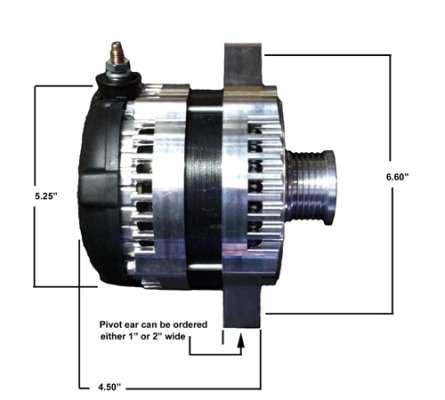here is some data for this discussion previously posted:
There is no question that bigger is better when talking alternators and DC charging systems. The heat issue ends up being the biggest enemy of the solid state parts as well as bearings etc on the alternator.
Using a large frame unit, then de-rating it via a smart regulator will ensure a long life for your system. Always use temp sensors on both the alternator and battery bank.
My boat came with a stock 60A small frame and when I asked it to try and charge a house bank around 500Amps, it simply could not do the job.
I then upgraded to a small frame on steroids 120A unit coupled with a smart regulator, which did an adequate job, but got REALLY hot.
Since my motor has a serpentine belt, it was a fairly simple matter to fit a large frame 200A unit, which charges my now very large 1350AH bank quite nicely. I have de-rated the alternator to 160A so it never runs at the max design in any circumstance.
If you have room and pulley/belt ability, just get a truck alternator - Ebay has lots of choices Leece/Nev 160-200A units are around $200.
It is always easier on the entire system to use less charging than you have available.
If you decide to upgrade the capacity of your Alternator, it will mean a number of 'other' costs as well.
First you must determine if your pulley/belt arrangement will be adequate. The normal rule of thumb is a single belt will safely give 100A or less. Dual belts or serpentine for greater than 100A. Determine if the side loading of the main bearing or waterpump you take off will be a problem.
As mentioned, if you change frame size, there can be mounting brackets etc to install/design.
Next, if you trade out a stock 60-70A internally regulated unit for a high-amp one, the cables will need to carry the extra juice - this normally means wire that is big enough - be sure to check a table or two for sizing properly - Don't forget fusing.
Of course, the Regulator will need to be a multi-stage unit. Balmar, Ample etc make some good equipment which will survive the marine environment well. The nice thing about these regulators is they are fully programable for the different stages of charging, battery types etc.
Then will come the 'how do I keep my start battery charged?" issue. These days an echo charge unit is hands down the best solution to the problem - Balmar, xantrex etc make good ones. This gets rid of the battery isolator - which never works well and makes more unwanted heat.
By this time you have spent some $$ and time designing a good DC system, so you will have already determined your usage needs and sized the house bank appropriately, and may decide it is time to make the bank bigger - thus necessitating buying an entire new house bank of AGM batteries to accept all these amps you now can produce.
You must also have a way of monitoring the beast - a link or other 'smart' monitor is pretty important to the health of your system.
It is a slippery slope when you really look at what is necessary to 'oversize' things.
The good news is you may just not need a generator after you get your DC system in shape.
below is a schematic showing the arrangement on my boat.
I have the ability to stay anchored in one location for up to 6 days and still be above 50% of Bank capacity. We usually stay 3 days max in any one place, but the option is there.
Good luck
Attached Thumbnails




